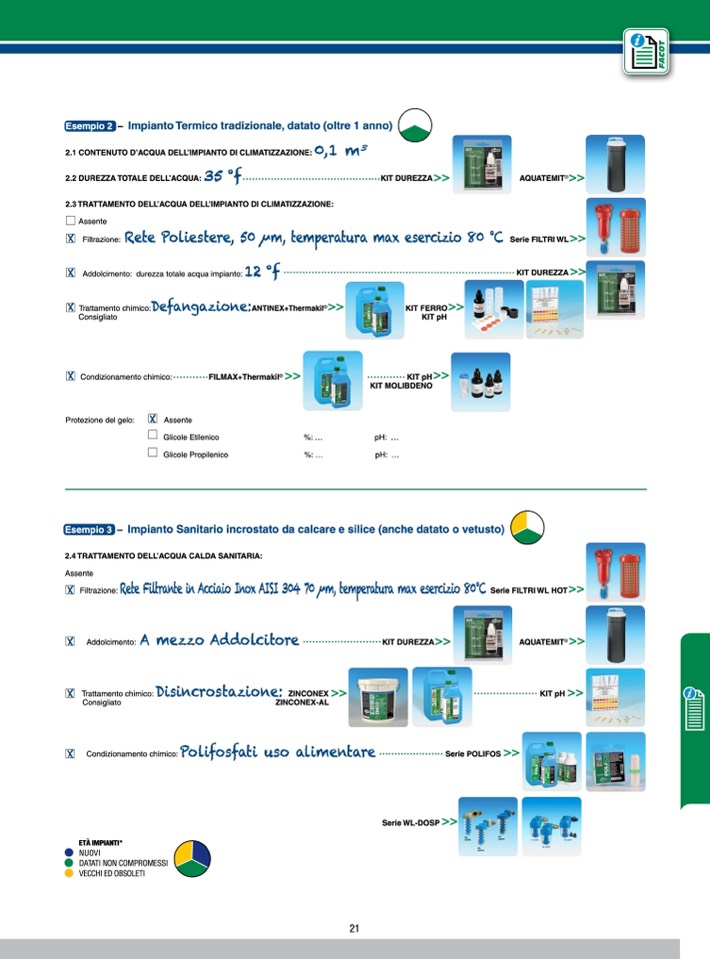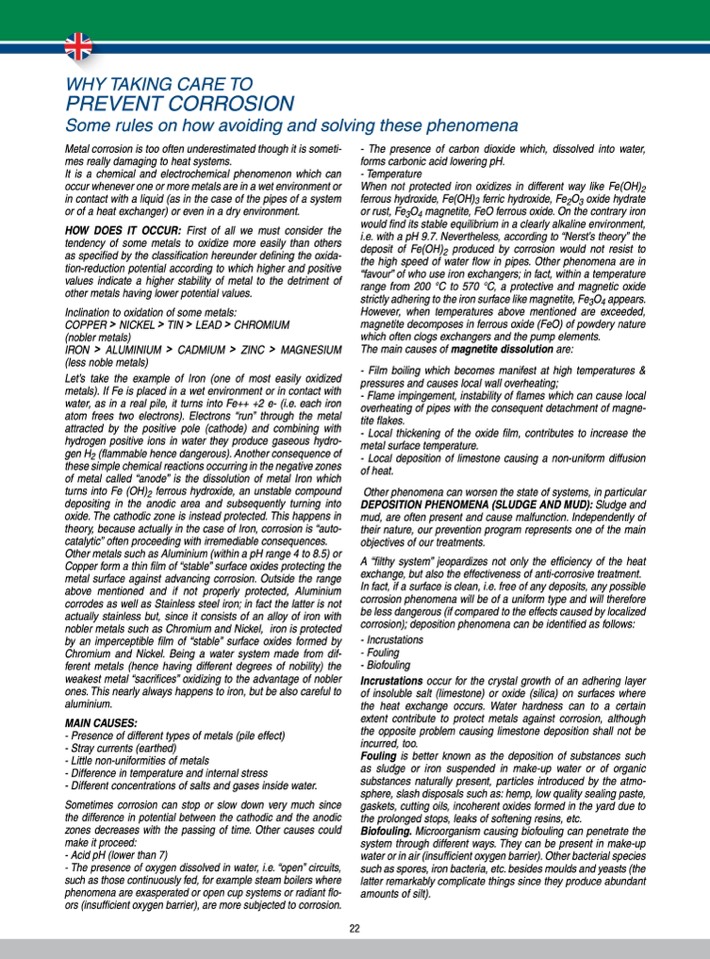


Metal corrosion is too often underestimated though it is someti-
mes really damaging to heat systems.
It is a chemical and electrochemical phenomenon which can
occur whenever one or more metals are in a wet environment or
in contact with a liquid (as in the case of the pipes of a system
or of a heat exchanger) or even in a dry environment.
HOW DOES IT OCCUR: First of all we must consider the
tendency of some metals to oxidize more easily than others
as specified by the classification hereunder defining the oxida-
tion-reduction potential according to which higher and positive
values indicate a higher stability of metal to the detriment of
other metals having lower potential values.
Inclination to oxidation of some metals:
COPPER > NICKEL > TIN > LEAD > CHROMIUM
(nobler metals)
IRON > ALUMINIUM > CADMIUM > ZINC > MAGNESIUM
(less noble metals)
Let’s take the example of Iron (one of most easily oxidized
metals). If Fe is placed in a wet environment or in contact with
water, as in a real pile, it turns into Fe++ +2 e- (i.e. each iron
atom frees two electrons). Electrons “run” through the metal
attracted by the positive pole (cathode) and combining with
hydrogen positive ions in water they produce gaseous hydro-
gen H
2
(flammable hence dangerous). Another consequence of
these simple chemical reactions occurring in the negative zones
of metal called “anode” is the dissolution of metal Iron which
turns into Fe (OH)
2
ferrous hydroxide, an unstable compound
depositing in the anodic area and subsequently turning into
oxide. The cathodic zone is instead protected. This happens in
theory, because actually in the case of Iron, corrosion is “auto-
catalytic” often proceeding with irremediable consequences.
Other metals such as Aluminium (within a pH range 4 to 8.5) or
Copper form a thin film of “stable” surface oxides protecting the
metal surface against advancing corrosion. Outside the range
above mentioned and if not properly protected, Aluminium
corrodes as well as Stainless steel iron; in fact the latter is not
actually stainless but, since it consists of an alloy of iron with
nobler metals such as Chromium and Nickel, iron is protected
by an imperceptible film of “stable” surface oxides formed by
Chromium and Nickel. Being a water system made from dif-
ferent metals (hence having different degrees of nobility) the
weakest metal “sacrifices” oxidizing to the advantage of nobler
ones. This nearly always happens to iron, but be also careful to
aluminium.
MAIN CAUSES:
- Presence of different types of metals (pile effect)
- Stray currents (earthed)
- Little non-uniformities of metals
- Difference in temperature and internal stress
- Different concentrations of salts and gases inside water.
Sometimes corrosion can stop or slow down very much since
the difference in potential between the cathodic and the anodic
zones decreases with the passing of time. Other causes could
make it proceed:
- Acid pH (lower than 7)
- The presence of oxygen dissolved in water, i.e. “open” circuits,
such as those continuously fed, for example steam boilers where
phenomena are exasperated or open cup systems or radiant flo-
ors (insufficient oxygen barrier), are more subjected to corrosion.
- The presence of carbon dioxide which, dissolved into water,
forms carbonic acid lowering pH.
- Temperature
When not protected iron oxidizes in different way like Fe(OH)
2
ferrous hydroxide, Fe(OH)3 ferric hydroxide, Fe
2
O
3
oxide hydrate
or rust, Fe
3
O
4
magnetite, FeO ferrous oxide. On the contrary iron
would find its stable equilibrium in a clearly alkaline environment,
i.e. with a pH 9.7. Nevertheless, according to “Nerst’s theory” the
deposit of Fe(OH)
2
produced by corrosion would not resist to
the high speed of water flow in pipes. Other phenomena are in
“favour” of who use iron exchangers; in fact, within a temperature
range from 200 °C to 570 °C, a protective and magnetic oxide
strictly adhering to the iron surface like magnetite, Fe
3
O
4
appears.
However, when temperatures above mentioned are exceeded,
magnetite decomposes in ferrous oxide (FeO) of powdery nature
which often clogs exchangers and the pump elements.
The main causes of magnetite dissolution are:
- Film boiling which becomes manifest at high temperatures &
pressures and causes local wall overheating;
- Flame impingement, instability of flames which can cause local
overheating of pipes with the consequent detachment of magne-
tite flakes.
- Local thickening of the oxide film, contributes to increase the
metal surface temperature.
- Local deposition of limestone causing a non-uniform diffusion
of heat.
Other phenomena can worsen the state of systems, in particular
DEPOSITION PHENOMENA (SLUDGE AND MUD): Sludge and
mud, are often present and cause malfunction. Independently of
their nature, our prevention program represents one of the main
objectives of our treatments.
A “filthy system” jeopardizes not only the efficiency of the heat
exchange, but also the effectiveness of anti-corrosive treatment.
In fact, if a surface is clean, i.e. free of any deposits, any possible
corrosion phenomena will be of a uniform type and will therefore
be less dangerous (if compared to the effects caused by localized
corrosion); deposition phenomena can be identified as follows:
- Incrustations
- Fouling
- Biofouling
Incrustations occur for the crystal growth of an adhering layer
of insoluble salt (limestone) or oxide (silica) on surfaces where
the heat exchange occurs. Water hardness can to a certain
extent contribute to protect metals against corrosion, although
the opposite problem causing limestone deposition shall not be
incurred, too.
Fouling is better known as the deposition of substances such
as sludge or iron suspended in make-up water or of organic
substances naturally present, particles introduced by the atmo-
sphere, slash disposals such as: hemp, low quality sealing paste,
gaskets, cutting oils, incoherent oxides formed in the yard due to
the prolonged stops, leaks of softening resins, etc.
Biofouling. Microorganism causing biofouling can penetrate the
system through different ways. They can be present in make-up
water or in air (insufficient oxygen barrier). Other bacterial species
such as spores, iron bacteria, etc. besides moulds and yeasts (the
latter remarkably complicate things since they produce abundant
amounts of silt).
22



